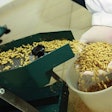The newly-launched Integris USA, LLC and its parent company, Calgary-based OPIsystems Inc., have an ambitious goal for U.S. commercial grain handlers and grain producers: Change your thinking about stored grain.
OPIsystems has sold its “Advanced Grain Management” systems throughout the world for more than two decades, and OPIsystems president and CEO Dave Crompton says that experience is what convinced him a sea change regarding stored grain was in order.
“All the sophisticated management and resources tied into maximizing yield and quality throughout the growing season is paid off at harvest,” he says, “That high-value crop is then stored in traditional storage that is run largely on chance, creating unnecessary risk.
“Without really knowing what’s happening inside that bin, the tendency is to over-aerate stored grain, which leads to increased electrical use and shrink, both of which bleed profits out of that grain asset.”
What's the big idea?
At the center of the Advanced Grain Management system is the concept that grain is an asset not a commodity, and thus, should be treated like an asset from the moment it enters the bin until it’s loaded out.
“Our automated monitoring and control systems are designed to help customers deliver grain which meets market specifications,” says Bruce Scott, COO Integris USA, LLC. “The ability to precisely condition grain to specific moisture and quality targets in the most efficient way, delivers a better end product at potentially significant savings.
“Some of our customers have experienced energy savings as much as 70 to 80% by aerating when ambient temperatures and humidity conditions are optimal and avoiding run times when peak-use demand charges are in effect,” Scott adds.
Integris employs OPI StorMax platform, featuring retractable sensing cables and digital sensing technology, a reengineered software platform based on its “OPIGIMAC” software. The Integris Basic system is designed for monitoring and alarm applications, while the Integris Pro system offers fully automated control of the storage conditions and energy use.
Both systems incorporate new features including easy-to-use and read, graphic interface which clearly and quickly communicate critical aspects of a user’s storage such as temperature, airflow and moisture content among others.
Does the advanced grain management concept have legs and if so, could it take a foothold with grain managers? Dirk Maier, Ph.D, head of the Department of Grain Science and Industry, Kansas State University, thinks so.
“The need for more sophisticated, real-time data retrieval is key to a manager’s ability to make real-time grain management decisions,” Maier notes. “It will require education to change the mindset around advanced monitoring but the need is real, as is the potential payoff.”
“As domestic corn use grows, for example, storage volumes, storage time and cost of ownership of that corn, grows as well,” surmises Maier. “If it’s possible to store that corn for months without sacrificing quality and reducing risk of shrink, that represents real value that goes straight to a manger’s bottom line.”
For OPIsystems, drawing upon the 20+ years of honing and developing advanced grain management systems coupled with the success seen by customers who helped fine-tune these systems, made the decision to launch Integris into the U.S. an obvious one.
“Our systems’ performance in the U.S. warranted the need to invest in a complete, locally supported solutions that includes sales and distribution, marketing and technical support services,” says Scott. “We plan on using a targeted launch to ensure we don’t overextend our ability to serve the marketplace with the goal of eventually expanding our presence in the United States and taking grain management practices to a higher plane.”
Early reports look good
The reasons why people consider Integris systems are as different and varied as the grain operations themselves, but all are linked by a common thread . . . the need for better information on the condition of their grain.
“We had a system that didn’t serve our needs and wasn’t real user-friendly so we installed the Integris system when we built a new 200,000 bushel bin in 2006 and two more 200,000 bushel bins since then,” says Bob Reynolds, general manager, Buckingham Cooperative, Buckingham, IA. “We thought if we knew exactly what shape our grain was in we could be more efficient with our fan run times.
“Each year is different but last fall for we cut our run time by one-third. I can’t tell you how much that is exactly, but it’s enough to make a difference,” Reynolds notes. “Like anything its not 100% perfect, but it’s much better than what we had and it’s another tool at our disposal to help maintain grain quality.
“If we aren’t successful in keeping corn in condition, we’d have to find another market for it and the last thing we need is to limit my marketing options,” he adds.
For Dan Imler, grain superintendant at Farmer’s Cooperative in Yale, IA, the system represents a new level of control he never had before when conditioning his grain.
“I was looking for better information out of a monitoring system and we experienced a great deal of variability in the data we were working with and maintaining quality was quite a challenge,” Imler recalls. “The OPIsystem seemed to make sense to me and with the programmability, the steady updates and the graph systems which tell me exactly what’s happening inside that bin, I was and still am, very impressed with the system.”
Imler predicts that by the time his bins are empty he will have accumulated about 340 hours of run time — or half his previous run time — for his aeration systems in his 105-foot diameter, 700,000 bushel bin.
“I not only save labor and energy but, with each cable sending a readout every two hours, any hot spots that develop are dealt with almost instantly and that grain stays in great condition, and that’s what I really like about this system,” says Imler.
On the right track
While both Reynolds and Imler admit that visual inspections and smell tests of their stored grain will remain a part of their routine grain maintenance regimen, but having a new tool that feed back such volumes of date to the manager can only be a good thing.
Reynolds thinks the proof will be in the pudding when he sits down to evaluate the system’s performance after this year’s crop is out of the bins.
“Last year’s growing season resulted in higher moisture and lighter test weight corn being delivered to the elevator for drying and storage. If the Integris system can help keep this cornin condition, that will be impressive,” he says.
So has Integris created a “new category” in grain storage? That remains to be seen. But what they have succeeded in doing is enabling the grain manager to make decisions based on information that’s delivered accurately, completely and as close to real-time as possible.
If Integris delivers on its promise to service and support its system at a level of performance as high as its systems, that will give them a big leap closer to their goal.

















